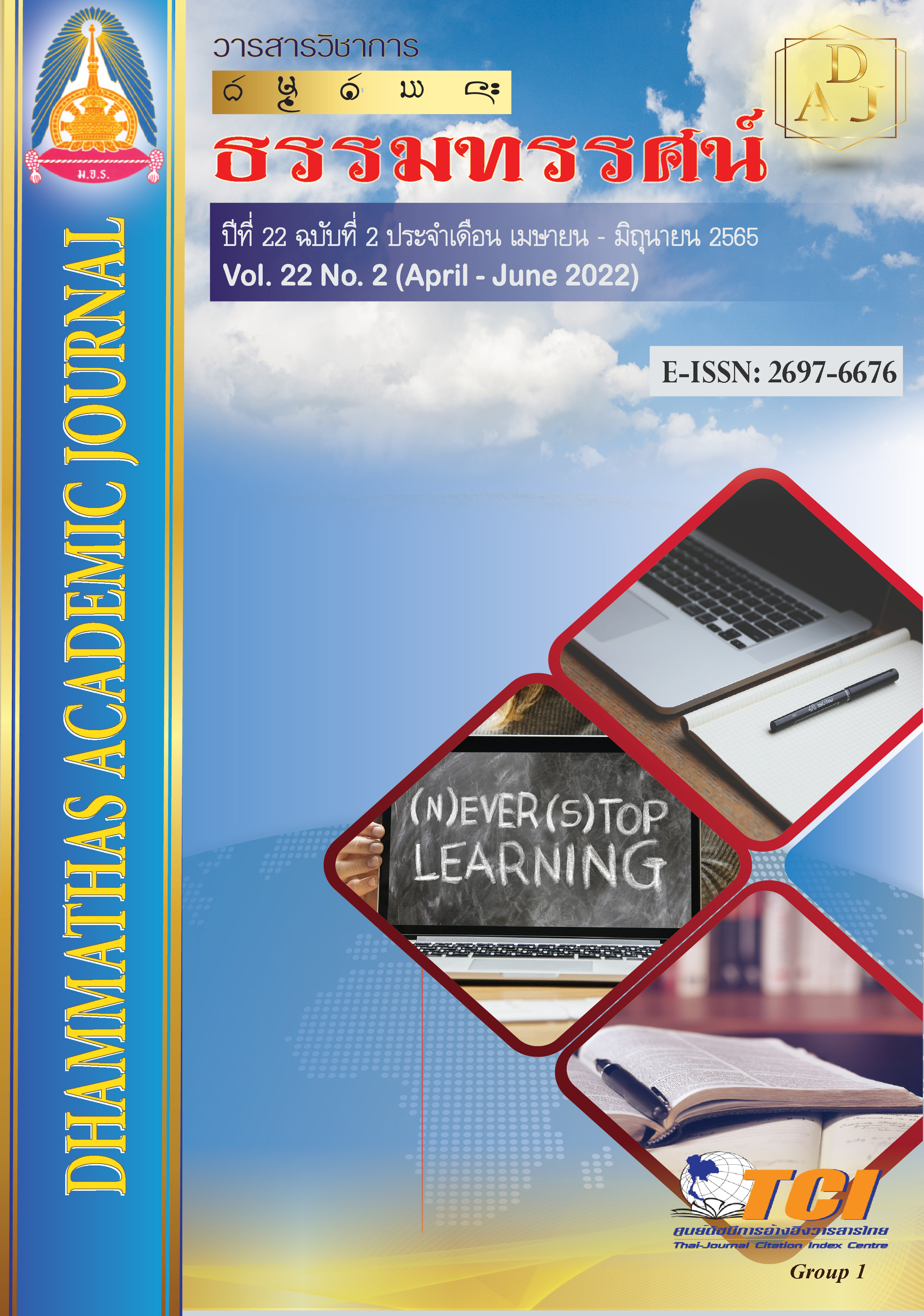Knowledge Management on Social Capital for Strengthening Local Communities with Participation of Civil Society in Pa Miang Subdistrict Municipality Area Doi Saket District Chiang Mai Province
Main Article Content
Abstract
This research aims to 1) Take out the lessons learned from knowledge management on social capital in the development of local communities in the past, 2) analyze social capital that shows the status and potential of the community in the knowledge management of social capital, 3) present a guideline for the development of Pa Miang Subdistrict Municipality and strengthen the participation of local communities. This research was carried out with a qualitative method of research and the Key informants include community leaders, corporate/agency representatives, and 50 residents. Various tools were used to collect data, which includes document data analysis, field survey, observations, interviews, group discussions including organizing of an exchange forum. The data were then analyzed, and content was synthesized according to the studied issues, which are presented in a descriptive form.
The results showed that:
1. Most of the context of Pa Miang Subdistrict Municipality is surrounded by natural resources such as Mae Kuang River Basin, which consists of 6 villages. Their way of life in the watershed area was in various forms. therefore, their social character was multicultural in which the local community has the following important social capital, such as (1) individual capital (2) learning resource fund, community organization (3) agency fund, network partners (4) cultural and local wisdom capital (5) natural resource and environment capital (6) Self-managed community grants. As a result, communities have to learn, adapt, and be able to survive in the midst of development and change.
2. The Social capital and potential of local communities in Pa Miang Subdistrict Municipality are characterized by natural resources, which are a source of learning and have a variety of lifestyles, that can indicate stability on a personal level with good integration and coordination with all sectors.
3. The result of the potential synthesis of social capital in the area using SWOT Analysis techniques led to the preparation of Pa Miang Subdistrict Municipality’s development strategy to strengthen the participation of the civil society in the local communities which consists of 4 strategies as follows: 1: Sustainable Resource Management, based on local culture 2: Cultural heritage, customs, traditions and wisdom. 3: Sufficiency, balance, and sustainable development of community economy 4: Building a learning society and well-being. This strategy is called PA MIANG Model, which is a strategy that experts and communities have assessed and certified through a community forum.
Article Details

This work is licensed under a Creative Commons Attribution-NonCommercial-NoDerivatives 4.0 International License.
เพื่อให้เป็นไปตามกฎหมายลิขสิทธิ์ ผู้นิพนธ์ทุกท่านต้องลงลายมือชื่อในแบบฟอร์มใบมอบลิขสิทธิ์บทความ ให้แก่วารสารฯ พร้อมกับบทความต้นฉบับที่ได้แก้ไขครั้งสุดท้าย นอกจากนี้ ผู้นิพนธ์ทุกท่านต้องยืนยันว่าบทความ ต้นฉบับที่ส่งมาตีพิมพ์นั้น ได้ส่งมาตีพิมพ์เฉพาะในวารสาร วิชาการธรรม ทรรศน์ เพียงแห่งเดียวเท่านั้น หากมีการใช้ ภาพหรือตารางของผู้นิพนธ์อื่นที่ปรากฏในสิ่งตีพิมพ์อื่นมาแล้ว ผู้นิพนธ์ต้องขออนุญาตเจ้าของลิขสิทธิ์ก่อน พร้อมทั้ง แสดงหนังสือที่ได้รับการยินยอมต่อบรรณาธิการ ก่อนที่บทความจะได้รับการตีพิมพ์References
ขวัญนภา สุขคร, เสาวธาร สมานิตย์, สิทธา พงษ์ศักดิ์, ฐิติวรฎา ใยสำลี, สิรณัฐเศรษฐ สุภาจันทรสุุข, ไผทเทพ ตุทานนท์, พ. ว. (2562). กระบวนการสร้างคุณค่าจากทุนทางสังคมวัฒนธรรม สู่การพัฒนาบนความเข้มแข็งและยั่งยืนของชุมชน ตำบลผาปัง อำเภอแม่พริก จังหวัดลำปาง. มหาวิทยาลัยสวนดุสิต
ฤทัยรัตน์ รัตนสร้อย. (2552). พลวัตทุนทางสังคมกับความเข้มแข็งของชุมชน: กรณีศึกษาบ้านจำรุง ตำบลเนินฆ้อ อำเภอแกลง จังหวัดระยอง. วิทยานิพนธ์หลักสูตรพัฒนาชุมชนมหาบัณฑิต,คณะสังคมสงเคราะห์ศาสตร์, มหาวิทยาลัยธรรมศาสตร์. วิทยานิพนธ์หลักสูตรพัฒนาชุมชนมหาบัณฑิต คณะสังคมสงเคราะห์ศาสตร์ มหาวิทยาลัยธรรมศาสตร์
ตรงกมล สนามเขต,นิตยา กาบจันทร์. (2565). แนวทางการเสริมสร้างทุนชุมชนให้เข้มแข็งสู่การกำหนด
ปัจจัยแห่งความสำเร็จ จังหวัดอุตรดิตถ์. วารสารวิจัยวิชาการ, 5 (1),129-144
ประเวศ วะสี. (2542). ชุมชนเข้มแข็ง ทุนทางสังคมของไทย: หนังสือชุดชุมชนเข้มแข็ง ลำดับที่ 1, กรุงเทพฯ: สำนักงานกองทุนเพื่อสังคม ธนาคารออมสิน
พิชชา บ้วแย้ม, ประสงค์ ตันพิชัย, สันติ ศรีสวนแตง. (2560). การดำรงอยู่ของทุนทางสังคมในชุมชนลุ่มน้ำมูลตอนล่าง : กรณีศึกษาตำบลโพธิ์ศรี อำเภอพิบูลมังสาหาร จังหวัดอุบลราชธานี. วารสารมนุษย์ สังคมศาสตร์ และศิลปะ, 10 (1),664-681
พระปลัดประพจน์ สุปภาโต, พระมหาประกาศิต สิริเมโธ, ทินกฤตพัชร์ รุ่งเมือง. (2563). ทุนทางสังคมกับการพัฒนาชุมชนวัดสำโรง อำเภอนครชัยศรี จังหวัดนครปฐม. วารสารสันติศึกษาปริทรรศน์ มจร. 8 (3),828-840
มานิตตา ชาญไชย. (2563).แนวทางการพัฒนาประเทศไทยสู่ความสมดุลและยั่งยืน. ศูนย์ศึกษายุทธศาสตร์ สถาบันวิชาการป้องกันประเทศ.
ไมตรี อินเตรียะ. (2560). ทุนทางสังคม. วารสารนาคบุตรปริทรรศน์, 9 (2),14-25
วาสนา มะลินิน,สัมพันธ์ สุกใส,นิตยา ปุระชาติ. (2562). การเกิดขึ้นและดำรงอยู่ของทุนทางสังคมในชุมชน
บ้านหัวอ่าว อำเภอสามพราน จังหวัดนครปฐม. วารสารศิลปะศาสตร์ราชมงคลสุวรรณภูมิ,1(1),53-63
วิทยา สุจริตธนารักษ์, ไพฑูรย์ บุญวัฒน์, ม.ร.ว.วุฒิเลิศ เทวกุล และเสริน ปุณณะหิตานนท์. (2560). การใช้ชุมชนเป็นฐานเพื่อพัฒนาทุนทางสังคม: กรณีศึกษา ชุมชนพื้นที่ภาคกลาง. วารสารวิชาการมหาวิทยาลัยปทุมธานี, 9 (2),205-211
วนิดา เสร็จกิจ. (2563). การพัฒนาชุมชนอย่างยั่งยืนในบริบทของการพัฒนาประเทศ. วารสารเศรษฐศาสตร์
การเมืองบูรพา, 8 (1), 81-106
สายไหม ไชยศิรินทร์. (2561). ทุนทางสังคมในกระบวนการแผนชุมชน บ้านมันแกว อำเภอกุดรัง จังหวัดมหาสารคาม. วารสารชุมชนวิจัย, 12 (ฉบับพิเศษ)
สำนักงานคณะกรรมการพัฒนาการเศรษฐกิจและสังคมแห่งชาติ. (2560). แผนพัฒนาเศรษฐกิจและสังคมแห่งชาติ ฉบับที่ 12 (2560-2564). กรุงเทพฯ : สำนักนายกรัฐมนตรี
Luang-Ubol J. (2010). Effects of Social Capital on the Psychosocial Wellbeing Among Thai Adolescents in the Northeast Region of Thailand. Doctor of Philosophy (Population and Development School of Applied Statistics). National Institute of Development Administration:Bangkok
Worms, J. (2009). Evaluating Social Capital as It Affects Community Development in the Favelas of Rio de Janeiro. Master's thesis. George Washington University: Washington D.C

